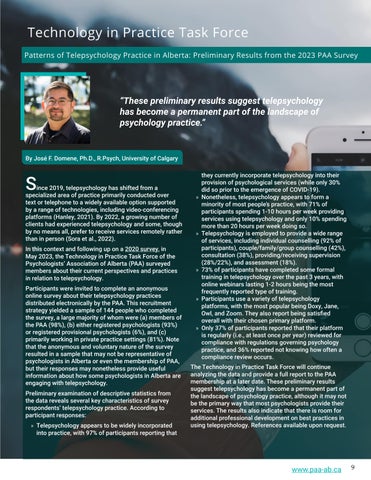Technology in Practice Task Force Patterns of Telepsychology Practice in Alberta: Preliminary Results from the 2023 PAA Survey
“These preliminary results suggest telepsychology has become a permanent part of the landscape of psychology practice.”
By José F. Domene, Ph.D., R.Psych, University of Calgary
S
ince 2019, telepsychology has shifted from a specialized area of practice primarily conducted over text or telephone to a widely available option supported by a range of technologies, including video-conferencing platforms (Hanley, 2021). By 2022, a growing number of clients had experienced telepsychology and some, though by no means all, prefer to receive services remotely rather than in person (Sora et al., 2022). In this context and following up on a 2020 survey, in May 2023, the Technology in Practice Task Force of the Psychologists’ Association of Alberta (PAA) surveyed members about their current perspectives and practices in relation to telepsychology. Participants were invited to complete an anonymous online survey about their telepsychology practices distributed electronically by the PAA. This recruitment strategy yielded a sample of 144 people who completed the survey, a large majority of whom were (a) members of the PAA (98%), (b) either registered psychologists (93%) or registered provisional psychologists (6%), and (c) primarily working in private practice settings (81%). Note that the anonymous and voluntary nature of the survey resulted in a sample that may not be representative of psychologists in Alberta or even the membership of PAA, but their responses may nonetheless provide useful information about how some psychologists in Alberta are engaging with telepsychology. Preliminary examination of descriptive statistics from the data reveals several key characteristics of survey respondents’ telepsychology practice. According to participant responses: » Telepsychology appears to be widely incorporated into practice, with 97% of participants reporting that
they currently incorporate telepsychology into their provision of psychological services (while only 30% did so prior to the emergence of COVID-19). » Nonetheless, telepsychology appears to form a minority of most people’s practice, with 71% of participants spending 1-10 hours per week providing services using telepsychology and only 10% spending more than 20 hours per week doing so. » Telepsychology is employed to provide a wide range of services, including individual counselling (92% of participants), couple/family/group counselling (42%), consultation (38%), providing/receiving supervision (28%/22%), and assessment (18%). » 73% of participants have completed some formal training in telepsychology over the past 3 years, with online webinars lasting 1-2 hours being the most frequently reported type of training. » Participants use a variety of telepsychology platforms, with the most popular being Doxy, Jane, Owl, and Zoom. They also report being satisfied overall with their chosen primary platform. » Only 37% of participants reported that their platform is regularly (i.e., at least once per year) reviewed for compliance with regulations governing psychology practice, and 36% reported not knowing how often a compliance review occurs. The Technology in Practice Task Force will continue analyzing the data and provide a full report to the PAA membership at a later date. These preliminary results suggest telepsychology has become a permanent part of the landscape of psychology practice, although it may not be the primary way that most psychologists provide their services. The results also indicate that there is room for additional professional development on best practices in using telepsychology. References available upon request.
www.paa-ab.ca
9





